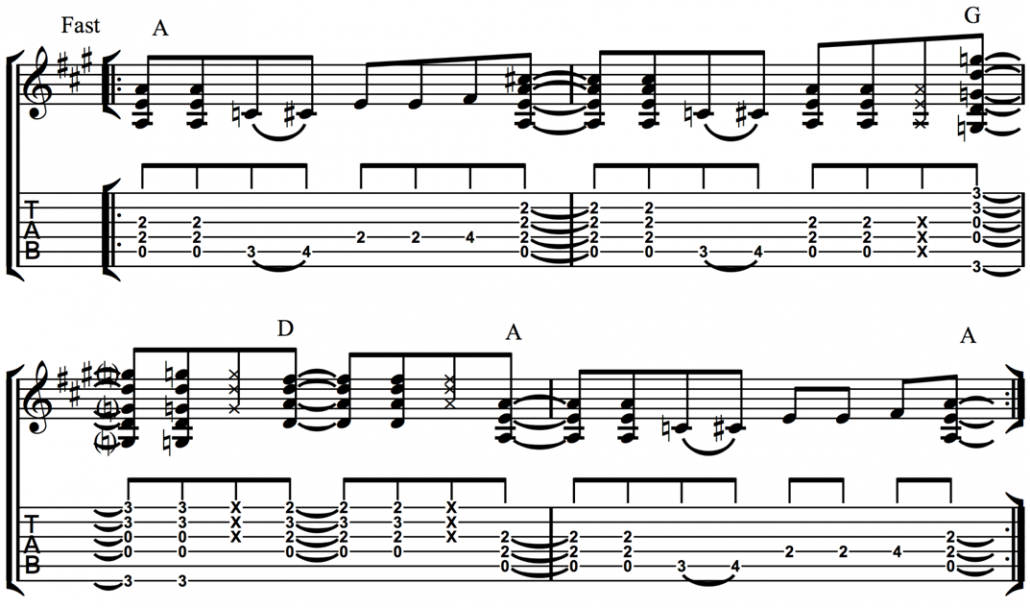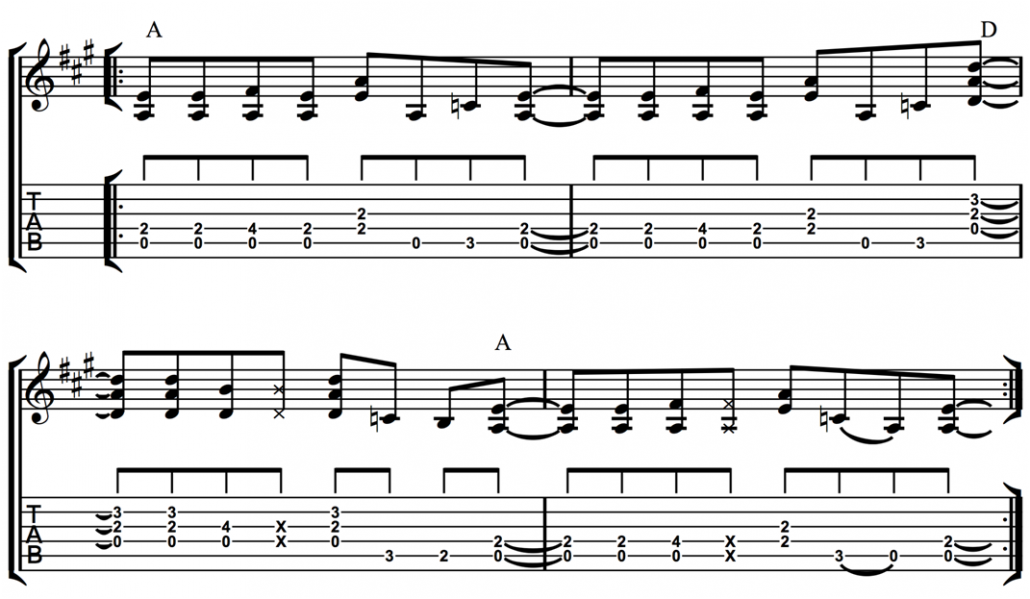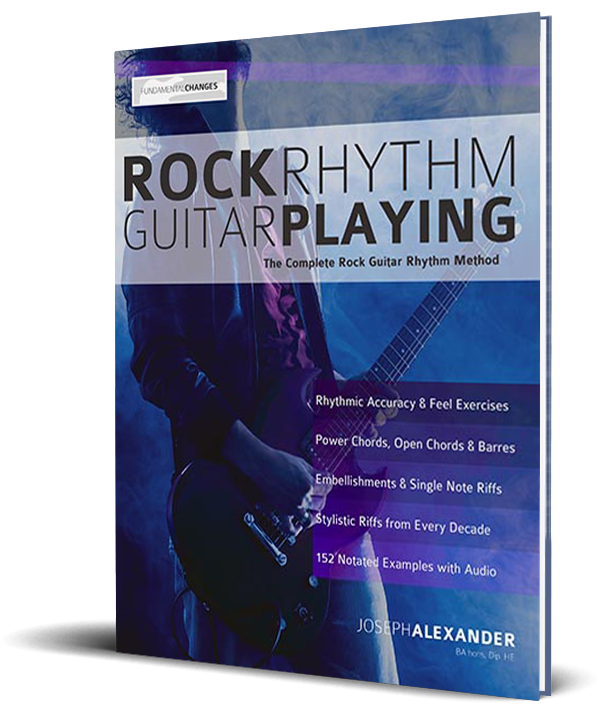Rock Guitar Chords: Open Position
Rock Guitar Chords:
While open-position chords are often associated with acoustic guitar playing, they are also a regular part of many rock guitar riffs. In fact, the use of open chords in rock is a thread that runs from the early beginnings of rock in the ‘50s right through to the modern day.
It is strange today to think of musicians like Bill Haley, Cliff Richard, Buddy Holly and Ike Turner as cutting edge rock musicians, but in their day their music caused great controversy and public outrage while pushing the boundaries of popular music.
When playing open chords in rock we continually use slight note alterations or omissions to add interest, and make technical adjustments to keep them sounding tight and aggressive so they don’t get overpowered by the amplifier’s distortion.
While often used in isolation for rhythmic ‘vamps’, e.g., Summer of ‘69 by Bryan Adams, often the beauty of open chords lies in the fact that they can easily be adjusted or embellished to form interesting riffs and melodies around simple chord shapes. This is the approach taken by many great guitarists from Buddy Holly to Brian May to Angus Young.
We will begin with some simple rhythmic vamping ideas before developing them further.
Many chord vamps fall into similar structures. Quite often you will see something that is two or four bars long with a small fill at the end leading back to the beginning of the riff. In the following example, notice how the sequence is ‘pushed’, right from the first bar.
I use the following ‘splitting the chord’ technique and combine it with tight palm muting to create a percussive effect. Notice how the strumming is limited to just a few strings to keep the riff tight and controlled.
Rock guitar chords Example 6m:
Audio PlayerThe next idea uses just three chords but adds a rake to decorate the first chord. A rake is performed like a slightly slower strum where the pick is dragged or ‘raked’ through the strings to articulate every note. Listen to the audio to hear how this technique should sound.
Hold down the chord shown in each chord symbol, each melody note of the riff is contained in the held chord.
Rock guitar chords Example 6n:
Audio PlayerThe previous example was based on the style of Buddy Holly, but here is the same chord sequence with more of a punk/rock approach.
Rock guitar chords Example 6o:
Audio PlayerThe previous two examples show a contrasting use of the same chord progression, and teaches us a valuable lesson: In rock music there are many identical chord sequences but it’s how they are played that defines the feel of the music.
The following example is one of the most frequently heard rhythms in rock guitar playing. It is common in the music of Guns N’ Roses and many other hard rock bands. To play the muted scratches, relax the pressure of your fretting hand and add slight palm muting. I suggest that you use down-strums for every 1/8th note.
Rock guitar chords Example 6p:
Audio PlayerThe earliest rock n’ roll riffs grew out of the blues, and this influence has remained a continuous driving force in the development of rock. Many of these blues vamps have become rock staples and are often based around a single chord with variations and fills played in the bass. These ideas are often played in the ‘open keys’ of A, E and D Major.
The following riff idea is based in the key of A, but you could easily shift it into the key of E by moving the first chord down a string. Use your 1st finger to barre the open A chord.
Rock guitar chords Example 6q:
Audio PlayerThe following example is a standard rock rhythm idea that has been used by hundreds of artists, from the Rolling Stones to Status Quo. It is a variation of the previous idea, but incorporates more of a Texas-Blues style approach into the riff.
Notice that even though most of the voicings of the chords are just two-note selections of the bigger A and D Major chords, each chord can still be split into lower and upper sections. The bass notes are used to keep a ‘chugging’ rhythm feel and the higher notes of the chord are used to accent the chord in the riff.
You can keep this riff muted for a tight, percussive effect, or let the strings ring a little more for a more open, richer sound. Often both of these techniques will be used; tight and percussive in the verse and then open and ringing in the chorus to add energy and texture.
Any bluesy decorations to these chords are played using the spare fingers of the fretting hand.
Rock guitar chords Example 6r:
Audio PlayerThe ideas in the two previous examples can easily be combined and there are many possible ways to introduce in new chords and fills. Listen carefully to your favourite rock bands and you will hear these ideas occurring frequently.
For more blues guitar riffs check outThe Complete Guide to Playing Blues Guitar: Rhythm Guitar.
AC/DC are masters of using simple open chords to create anthemic rock guitar riffs. By combining split, muted and ringing chords they have managed to make some of the most memorable riffs of the past forty years.
Here’s an idea in a classic rock style.
Rock guitar chords Example 6s:
Audio PlayerAs always, listen to the audio example to get the right feel for this example. Notice how full strums are combined with smaller strums and single-string fills.
Here’s another example in a similar style.
Rock guitar chords Example 6t:
Audio PlayerThe previous example makes more use of right-hand mutes. Keep each A Major chord tight and percussive and let the D and G chords ring out.
As there are a fairly limited number of open-position chords used in classic rock riffs, often it’s only the rhythm of the progression that makes a chord sequence easily identifiable.
The following two examples demonstrate the same chord progression played in two different ways. The first is as a classic punk riff, and the second is an iconic ‘90s pop/rock song.
Rock guitar chords Example 6u:
Audio PlayerRock guitar chords Example 6v:
Audio PlayerOpen-position chords are a defining feature of many rock songs, and you will often see identical chord progressions used in different ways. Often for guitarists, songs are differentiated only by a particular rhythmic idea, tempo or lead guitar riff.
This lesson is an extract of my book, Rock Rhythm Guitar Playing, available now on Amazon
“The artists you work with, and the quality of your work speaks for itself.”
Tommy Emmanuel
© Copyright Fundamental Changes Ltd 2025
No.6 The Pound, Ampney Crucis, England, GL7 5SA











